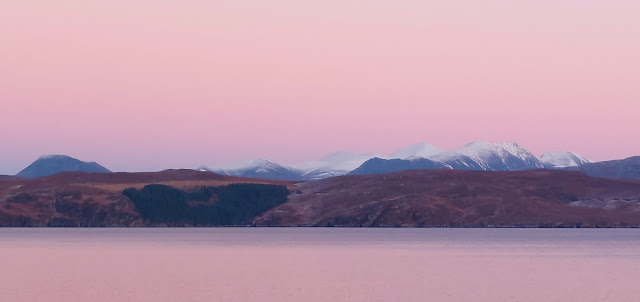The first few months of 2024 have seen some really poor weather conditions in Scotland. In the north-east of the country it was the wettest winter for many years and April was the coldest since 1905! When the forecast for the first few days of May showed warm and settled conditions on the west coast, Douglas and I made plans for a few days sea kayak camping.
We met at Mallaig mid-morning on a glorious day. A glance at the map shows how well positioned Mallaig is to access superb sea kayaking routes. Our plan would be very flexible and would largely be dictated by a forecast of variable winds from a generally easterly direction. Before packing our boats we took second breakfast of croissants and pains au chocolate with coffee from the excellent Mallaig Bakehouse and also bought a large focaccia bread to accompany dinner.
We were on the water and away shortly after noon and enjoyed a leisurely few hours paddle towards our first planned camp. As we'd both had long-ish drives to reach Mallaig we had no intention of pushing hard to make distance, it just wasn't that sort of a day. A light breeze from astern helped push us gently along as we paddle-sailed a shoreline alive with the sounds of Willow Warblers and echoing to the calls of Cuckoos.
Arriving at a camp we've used before is a bit like meeting an old friend; one looks for the subtle changes and reminisces about good times. We were pleased to see not much had changed here and that the bracken hadn't started reaching up, making for a better range of pitches. We got our tents up, enjoyed a coffee and then went for a walk. Douglas and I both enjoy the off-water parts of a sea kayak trip as much as the paddling, exploring and just being in a place adds so much to the experience.
We climbed above the shore and through woods of birch and oak to a stretch of higher ground which had clear signs that this now deserted shore was once worked by a community. "Run Rig" furrow marks were everywhere, testament to back-breaking work over generations to make something of the poor, acid soils by fertilising with seaweed and dung.
Croft houses, some little more than a gable or a "rickle o'stanes" dot the ground near the shore. It's likely that the occupants had been moved from better agricultural ground inland to theses far edges to make way for sheep in the years of the Clearances. The houses had a superb situation, but a view won't feed your family and this was subsistence living at the extreme with starvation an ever-present threat.
Near the ruins of a more substantial house was this tractor which is slowly being consumed by rust and the boggy ground. We could make out that the engine was a Standard make, but little else - it would be fascinating to learn something of its story.
Just around here we were treated to one of the experiences which really make a trip. Overhead we heard the distinctive "kyow-kyow" call of a White Tailed Eagle. looking up we saw not one but two birds flying purposefully overhead. But things got even better; a third, absolutely huge eagle (an adult female we think) launched from a nearby crag and engaged the two overflying birds. Twisting in mid-air and presenting its talons seemed to intimidate the two birds which flew quickly off. Then the third bird was harried relentlessly by a pair of Ravens which mobbed it all the way back to the crag - it was a great wildlife spectacle!
It was only four or so hours into our trip but already it felt that we'd been amply rewarded for making the effort to get out! Returning to our camp we gathered driftwood and some fallen birch branches for a fire and started to think about getting dinner prepared....






































.jpg)

